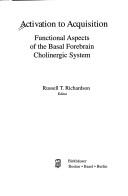| Listing 1 - 10 of 234 | << page >> |
Sort by
|
Book
Year: 1976 Publisher: New York (N.Y.): Raven
Abstract | Keywords | Export | Availability | Bookmark
 Loading...
Loading...Choose an application
- Reference Manager
- EndNote
- RefWorks (Direct export to RefWorks)

ISBN: 0272797774 9780272797778 Year: 1988 Volume: 107 Publisher: London Pitman
Abstract | Keywords | Export | Availability | Bookmark
 Loading...
Loading...Choose an application
- Reference Manager
- EndNote
- RefWorks (Direct export to RefWorks)
Basal Ganglia --- Basal ganglia --- physiology --- Congresses --- Basal Ganglia - physiology - congresses --- Basal ganglia - Congresses
Book
ISBN: 0674265459 0674040228 Year: 2000 Publisher: Cambridge, Massachusetts : Harvard University Press,
Abstract | Keywords | Export | Availability | Bookmark
 Loading...
Loading...Choose an application
- Reference Manager
- EndNote
- RefWorks (Direct export to RefWorks)
This book is an entry into the fierce current debate among psycholinguists, neuroscientists, and evolutionary theorists about the nature and origins of human language. A prominent neuroscientist here takes up the Darwinian case, using data seldom considered by psycholinguists and neurolinguists to argue that human language--though more sophisticated than all other forms of animal communication--is not a qualitatively different ability from all forms of animal communication, does not require a quantum evolutionary leap to explain it, and is not unified in a single "language instinct." Using clinical evidence from speech-impaired patients, functional neuroimaging, and evolutionary biology to make his case, Philip Lieberman contends that human language is not a single separate module but a functional neurological system made up of many separate abilities. Language remains as it began, Lieberman argues: a device for coping with the world. But in a blow to human narcissism, he makes the case that this most remarkable human ability is a by-product of our remote reptilian ancestors' abilities to dodge hazards, seize opportunities, and live to see another day.
Book
Year: 1962 Publisher: London Oxford university
Abstract | Keywords | Export | Availability | Bookmark
 Loading...
Loading...Choose an application
- Reference Manager
- EndNote
- RefWorks (Direct export to RefWorks)
Book
ISBN: 9090032797 Year: 1990 Publisher: Nijmegen : SSN,
Abstract | Keywords | Export | Availability | Bookmark
 Loading...
Loading...Choose an application
- Reference Manager
- EndNote
- RefWorks (Direct export to RefWorks)
Periodical
ISSN: 22105344 22105336 Year: 2011 Publisher: Amsterdam : Elsevier
Abstract | Keywords | Export | Availability | Bookmark
 Loading...
Loading...Choose an application
- Reference Manager
- EndNote
- RefWorks (Direct export to RefWorks)
Basal ganglia --- Basal Ganglia Diseases. --- Diseases --- Diseases. --- Basal Ganglia Disorders --- Lenticulostriate Disorders --- Extrapyramidal Disorders --- Basal Ganglia Disease --- Basal Ganglia Disorder --- Extrapyramidal Disorder --- Lenticulostriate Disorder --- Ganglia, Basal --- Efferent pathways --- Extrapyramidal tracts --- Telencephalon --- Health Sciences --- Neurology
Book
ISBN: 0444904204 Year: 1986 Publisher: Amsterdam Elsevier
Abstract | Keywords | Export | Availability | Bookmark
 Loading...
Loading...Choose an application
- Reference Manager
- EndNote
- RefWorks (Direct export to RefWorks)
Basal Ganglia Diseases. --- Extrapyramidal disorders --- Disorders, Extrapyramidal --- Extrapyramidal tracts --- Central nervous system --- Movement disorders --- Basal Ganglia Disorders --- Lenticulostriate Disorders --- Extrapyramidal Disorders --- Basal Ganglia Disease --- Basal Ganglia Disorder --- Extrapyramidal Disorder --- Lenticulostriate Disorder --- Diseases --- Extrapyramidal disorders. --- Basal Ganglia Diseases
Book
Abstract | Keywords | Export | Availability | Bookmark
 Loading...
Loading...Choose an application
- Reference Manager
- EndNote
- RefWorks (Direct export to RefWorks)
Eye movements provide rich source of information about brain functioning for neurologists and neuroscientists. They provide diagnostic clues, define, and localize motor and cognitive disorders. Objective eye movement assessments associated with clinical observation and genetic testing in neurodegenerative, neurometabolic, and neurogenetic diseases provide insight into their pathophysiology and disease mechanism. Finally the eye movements may be used for testing and following the response to therapies. The concrete value of studying eye movement stems from a number of advantages compared to the study of movements of axial or limb muscles.
The eye movements are accessible to clinical inspection, they can be measured precisely, their interpretation is clear and therefore ocular motility examination has high localization value. There are several standardized tasks to study of each subclass of eye movements that are recognized for motor or cognitive behavior. Indeed the studies of eye movement had allowed test of motor and cognitive functions of the brain in a vast range of neurological disease. Both cortical and subcortical dysfunctions may be detected with the analysis of subclasses of eye movements and interpreted in association with other clinical, laboratory and neuroimaging features.
The goal of this topic-focused volume of Frontiers in Neurology is to gather seminal studies, from well-known scientists and laboratories from across the world, delineating the features of eye movements and vestibular system in neurogenetic, neurometabolic, and neurodegenerative disorders. Such collection of articles, to our knowledge, is unique and never done in the past. The topics and the compilation will be of interest to broad groups of neuroscientists and neurologists for the reasons as follows:
1) Neurodegenerative diseases represent a large portion of neurological diseases encountered in neurological clinical practice. Eye movement changes may occur early in their course and may be specific, thus orienting the diagnosis.
2) Neurometabolic and neurogenetic conditions, although rare, show specific and characteristic eye movements that represent the hallmark of the disease. Such disorders often represent a pathologic model that helps to understand the normal functioning of specific brain regions and networks.
genetic --- tremor --- immune --- basal ganglia --- ataxia --- nystagmus --- parkinson --- degenerative --- cerebellum

ISBN: 3764334673 Year: 1991 Publisher: Basel : Birkhäuser,
Abstract | Keywords | Export | Availability | Bookmark
 Loading...
Loading...Choose an application
- Reference Manager
- EndNote
- RefWorks (Direct export to RefWorks)
Basal ganglia --- Cholinergic fibers --- Cholinergic mechanisms. --- Prosencephalon. --- Physiology. --- Physiology.
Book
ISBN: 0387817565 Year: 1983 Publisher: Wien ; New York : Springer-Verlag,
Abstract | Keywords | Export | Availability | Bookmark
 Loading...
Loading...Choose an application
- Reference Manager
- EndNote
- RefWorks (Direct export to RefWorks)
Extrapyramidal disorders. --- Parkinson's disease. --- Basal ganglia diseases. --- Parkinson disease.
| Listing 1 - 10 of 234 | << page >> |
Sort by
|

 Search
Search Feedback
Feedback About
About Help
Help News
News